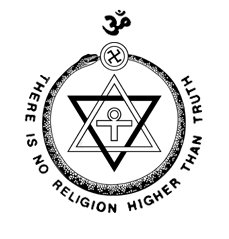
Helena Petrovna Blavatsky, often known as Madame Blavatsky, was a Russian and American mystic and author who co-founded the Theosophical Society in 1875. She gained an international following as the leading theoretician of Theosophy.

Erich Anton Paul von Däniken is a Swiss author of several pseudoscientific books which make claims about extraterrestrial influences on early human culture, including the best-selling Chariots of the Gods?, published in 1968. Von Däniken is one of the main figures responsible for popularizing the "paleo-contact" and ancient astronauts hypotheses.

Alice Ann Bailey was a writer of more than twenty-four books on theosophical subjects, and was one of the first writers to use the term New Age. Bailey was born as Alice La Trobe-Bateman, in Manchester, England. She moved to the United States in 1907, where she spent most of her life as a writer and teacher.

The Secret Doctrine, the Synthesis of Science, Religion and Philosophy, is a pseudoscientific esoteric book as two volumes in 1888 written by Helena Blavatsky. The first volume is named Cosmogenesis, the second Anthropogenesis. It was an influential example of the revival of interest in esoteric and occult ideas in the modern age, in particular because of its claim to reconcile ancient eastern wisdom with modern science. Proponents widely claim the literature contains clues as to how the nature of prayer was 'covered' and expunged from common wisdom, except for those with a keen eye.

Alfred Percy Sinnett was an English author and theosophist.

Isis Unveiled: A Master-Key to the Mysteries of Ancient and Modern Science and Theology, published in 1877, is a book of esoteric philosophy and Helena Petrovna Blavatsky's first major work and a key text in her Theosophical movement.
Djwal Khul, is believed by some Theosophists and others to be a Tibetan disciple in "The Ageless Wisdom" esoteric tradition. The texts describe him as a member of the 'Spiritual Hierarchy', or 'Brotherhood', of Mahatmas, one of the Masters of the Ancient Wisdom, defined as the spiritual guides of mankind and teachers of ancient cosmological, metaphysical, and esoteric principles that form the origin of all the world's great philosophies, mythologies and spiritual traditions. According to Theosophical writings, Djwal Khul is said to work on furthering the spiritual evolution of our planet through the teachings offered in the 24 books by Alice Bailey of Esoteric Teachings published by The Lucis Trust ; he is said to have telepathically transmitted the teachings to Bailey and is thus regarded by her followers as the communications director of the Masters of the Ancient Wisdom.

Morya, also spelt Maurya, is one of the "Masters of the Ancient Wisdom" within modern Theosophical beliefs. He is believed by followers of Theosophism to be one of the Mahatmas who inspired the founding of the Theosophical Society and was engaged in a correspondence with two English Theosophists living in India, A. P. Sinnett and A. O. Hume. The correspondence was published in 1923 by A. Trevor Barker, in the book The Mahatma Letters to A. P. Sinnett.

Curuppumullage Jinarajadasa was a Ceylonese author, occultist, freemason and theosophist. The fourth president of the Theosophical Society, Jinarajadasa was one of the world's foremost Theosophical authors, having published more than 50 books and more than 1600 articles in periodicals during his life. His interests and writings included religion, philosophy, literature, art, science and occult chemistry. He was also a rare linguist, who had the ability to work in many European languages.

The Mahatma Letters to A.P. Sinnett is a book published in 1923 by A. Trevor Barker. (ISBN 1-55700-086-7) According to Theosophical teachings, the letters were written between 1880 and 1884 by Koot Hoomi and Morya to A. P. Sinnett. The letters were previously quoted in several theosophical books, but not published in full. The letters were important to the movement due to their discussions on the theosophical cosmos and spiritual hierarchy. From 1939, the original letters were in the possession of the British Museum but later the British Library.

Theosophical teachings have borrowed some concepts and terms from Buddhism. Some theosophists like Helena Blavatsky, Helena Roerich and Henry Steel Olcott also became Buddhists. Henry Steel Olcott helped shape the design of the Buddhist flag. Tibetan Buddhism was popularised in the West at first mainly by Theosophists including Evans-Wentz and Alexandra David-Neel.
The Great White Brotherhood, in belief systems akin to Theosophy and New Age, are said to be perfected beings of great power who spread spiritual teachings through selected humans. The members of the Brotherhood may be known as the Masters of the Ancient Wisdom, the Ascended Masters, the Church Invisible, or simply as the Hierarchy. The first person to talk about them in the West was Helena Petrovna Blavatsky (Theosophy), after she and other people claimed to have received messages from them. These included Helena Roerich, Alice A. Bailey, Guy Ballard, Geraldine Innocente, Elizabeth Clare Prophet, Bob Sanders, and Benjamin Creme.

In Theosophy, Maitreya or Lord Maitreya is an advanced spiritual entity and high-ranking member of a reputed hidden spiritual hierarchy, the Masters of the Ancient Wisdom. According to Theosophical doctrine, one of the hierarchy's functions is to oversee the evolution of humankind; in concert with this function Maitreya is said to hold the "Office of the World Teacher". Theosophical texts posit that the purpose of this Office is to facilitate the transfer of knowledge about the true constitution and workings of Existence to humankind. Humanity is thereby assisted on its presumed cyclical, but ever progressive, evolutionary path. Reputedly, one way the knowledge transfer is accomplished is by Maitreya occasionally manifesting or incarnating in the physical realm; the manifested entity then assumes the role of World Teacher of Humankind.

Senzar is a supposed original language of the stanzas of Dzyan. It is referenced in multiple locations in works of Helena Blavatsky.
David Reigle is an American author and an independent scholar of the Sanskrit scriptures of India and their Tibetan translations. He has written on the Buddhist Kālacakra teachings, and has published research on the sourcebooks accepted in Theosophy. These are the Books of Kiu-te, i.e., rgyud-sde, the Tibetan Buddhist tantras, and the so-called Book of Dzyan, which still remains unidentified.

Within the system of Theosophy, developed by occultist Helena Blavatsky and others since the second half of the 19th century, Theosophical mysticism draws upon various existing disciplines and mystical models, including Neo-platonism, Gnosticism, Western esotericism, Freemasonry, Hinduism and Buddhism.

Theosophy is a religion established in the United States during the late 19th century. It was founded primarily by Helena Blavatsky and draws its teachings predominantly from Blavatsky's writings. Categorized by scholars of religion as both a new religious movement and as part of the occultist stream of Western esotericism, it draws upon both older European philosophies such as Neoplatonism and Indian originated religions such as Hinduism and Buddhism.

Esoteric Buddhism is a book originally published in 1883 in London; it was compiled by a member of the Theosophical Society, A. P. Sinnett. It was one of the first books written for the purpose of explaining theosophy to the general public, and was "made up of the author's correspondence with an Indian mystic." This is the most significant theosophical work of the author. According to Goodrick-Clarke, it "disseminated the basic teachings of Theosophy in its new Asian cast."

William Emmette Coleman, also known as W. E. Coleman, was an American clerk, Orientalist, spiritualist and writer.
According to some literary and religious studies scholars, modern Theosophy had a certain influence on contemporary literature, particularly in forms of genre fiction such as fantasy and science fiction. Researchers claim that Theosophy has significantly influenced the Irish literary renaissance of the late 19th and early 20th centuries, notably in such figures as W. B. Yeats and G. W. Russell.











